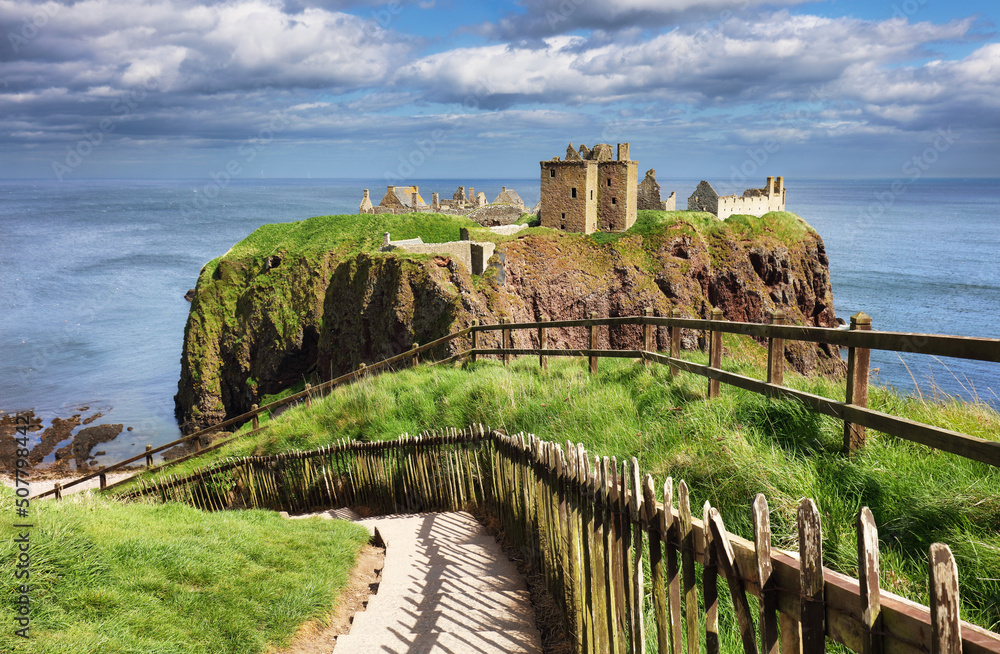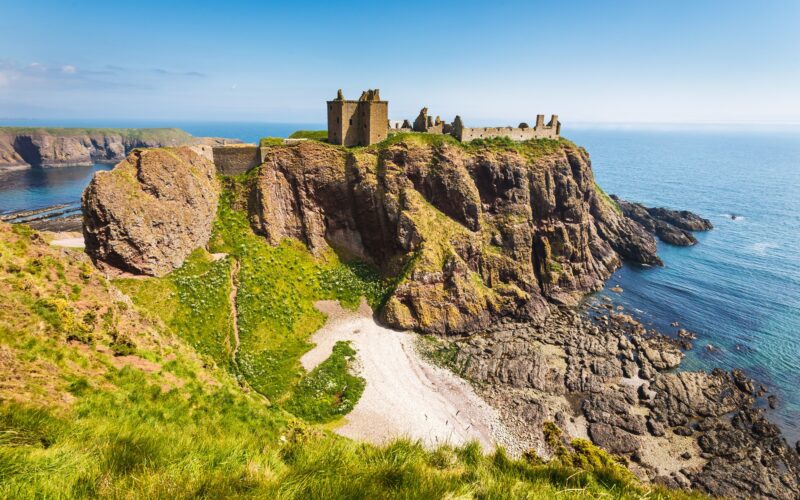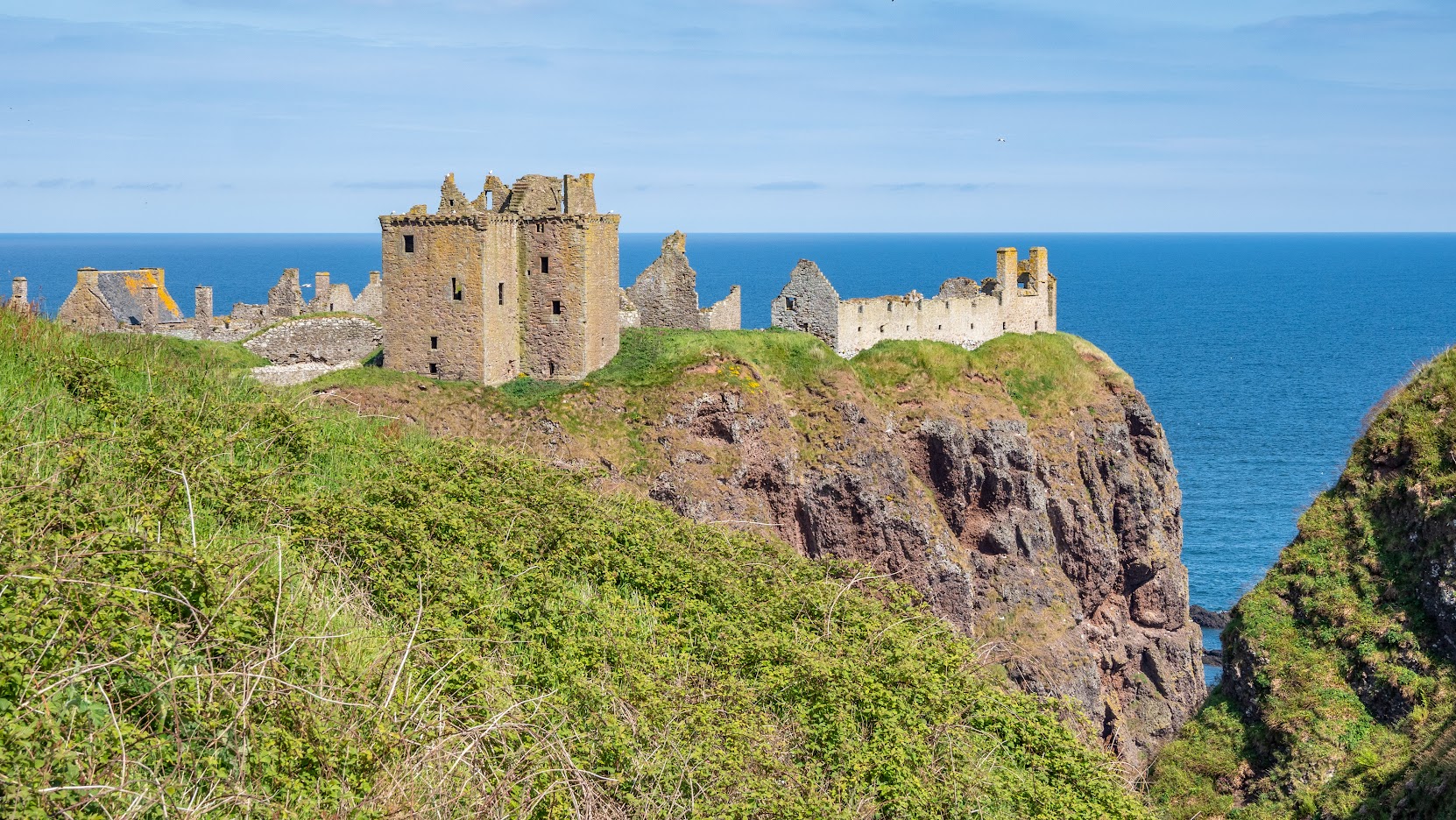A History of Power and Siege
Dunnottar Castle’s origins date back to at least the 3rd century AD, with evidence suggesting it was used as a Pictish fort before becoming a site of significant medieval importance. Its natural defenses—a sheer cliff face on three sides and a narrow strip of land connecting it to the mainland—made it nearly impenetrable, earning it the reputation of a fortress of great strength.
Over the centuries, the castle became a stronghold for various noble families, most notably the Earls Marischal, one of the most powerful families in Scottish history. Their wealth and influence grew with the castle, making it not only a military stronghold but also a symbol of their dominance.

The Crown Jewels and the Siege of 1651
One of Dunnottar Castle’s most famous moments in history came during the 17th century. In 1651, amid the Wars of the Three Kingdoms, the English Parliamentarian forces under Oliver Cromwell invaded Scotland. Cromwell sought to capture the Scottish Crown Jewels, known as the Honours of Scotland, which symbolized the sovereignty of the Scottish nation.
Anticipating Cromwell’s invasion, the Honours were secretly moved to Dunnottar Castle for safekeeping. Despite a siege that lasted eight months, the castle’s defenders held out. However, the eventual surrender seemed inevitable, and the Honours were smuggled out by a local minister’s wife, Christian Fletcher, hidden in sacks of wool. The jewels were buried under a church floor, preventing them from falling into Cromwell’s hands and preserving Scotland’s independence and history.

A Site of Tragedy
Dunnottar Castle is also the site of darker chapters in history. In 1685, during the reign of King James II, a group of Covenanters—Scottish Presbyterians who opposed the king’s attempts to impose Anglican practices on the Scottish church—were imprisoned in the castle’s dungeon. Known as the Whig’s Vault, the cramped and miserable conditions led to the deaths of many prisoners. The survivors were later either executed or sent into exile.
This tragic episode is a testament to the castle’s role as a place of suffering as well as triumph, reflecting Scotland’s long and often bloody fight for religious and political freedom.

The Decline and Legacy
By the early 18th century, Dunnottar Castle fell into disrepair following the downfall of the Earls Marischal, who were accused of treason for their involvement in the Jacobite uprising of 1715. The castle was abandoned, leaving it to the mercy of the elements.
Today, the ruins of Dunnottar stand as a haunting reminder of Scotland’s past. Its weathered stone walls, commanding position, and breathtaking views continue to inspire awe and wonder. The site has been featured in films and media, most notably in Franco Zeffirelli’s 1990 version of Hamlet, starring Mel Gibson.

Visiting Dunnottar Castle
A visit to Dunnottar Castle is an unforgettable experience. The rugged coastal scenery, the towering cliffs, and the dramatic approach to the castle set the tone for an exploration of the ruins. Visitors can wander through the remains of the medieval keep, the barracks, and the chapel, all while imagining the lives of those who once inhabited the fortress.
The castle is also a popular destination for those interested in Scotland’s natural beauty. The surrounding area is rich in wildlife, and the cliffs are home to seabirds such as puffins and guillemots. The nearby town of Stonehaven, with its quaint harbor and charming local shops, provides a perfect stopover after a day of exploring the castle.

Conclusion
Dunnottar Castle is more than just a ruin; it is a symbol of Scottish resilience, ingenuity, and spirit. Its story, from its early beginnings as a Pictish fort to its role in safeguarding the Honours of Scotland, makes it a must-visit site for history enthusiasts and travelers alike. Standing on its windswept cliffs, one cannot help but feel the weight of history and the indomitable spirit of a nation that has endured through the ages.
Whether you visit for its historical significance or simply to take in the stunning scenery, Dunnottar Castle offers a glimpse into the heart of Scotland’s past and the legends that continue to shape its present.

